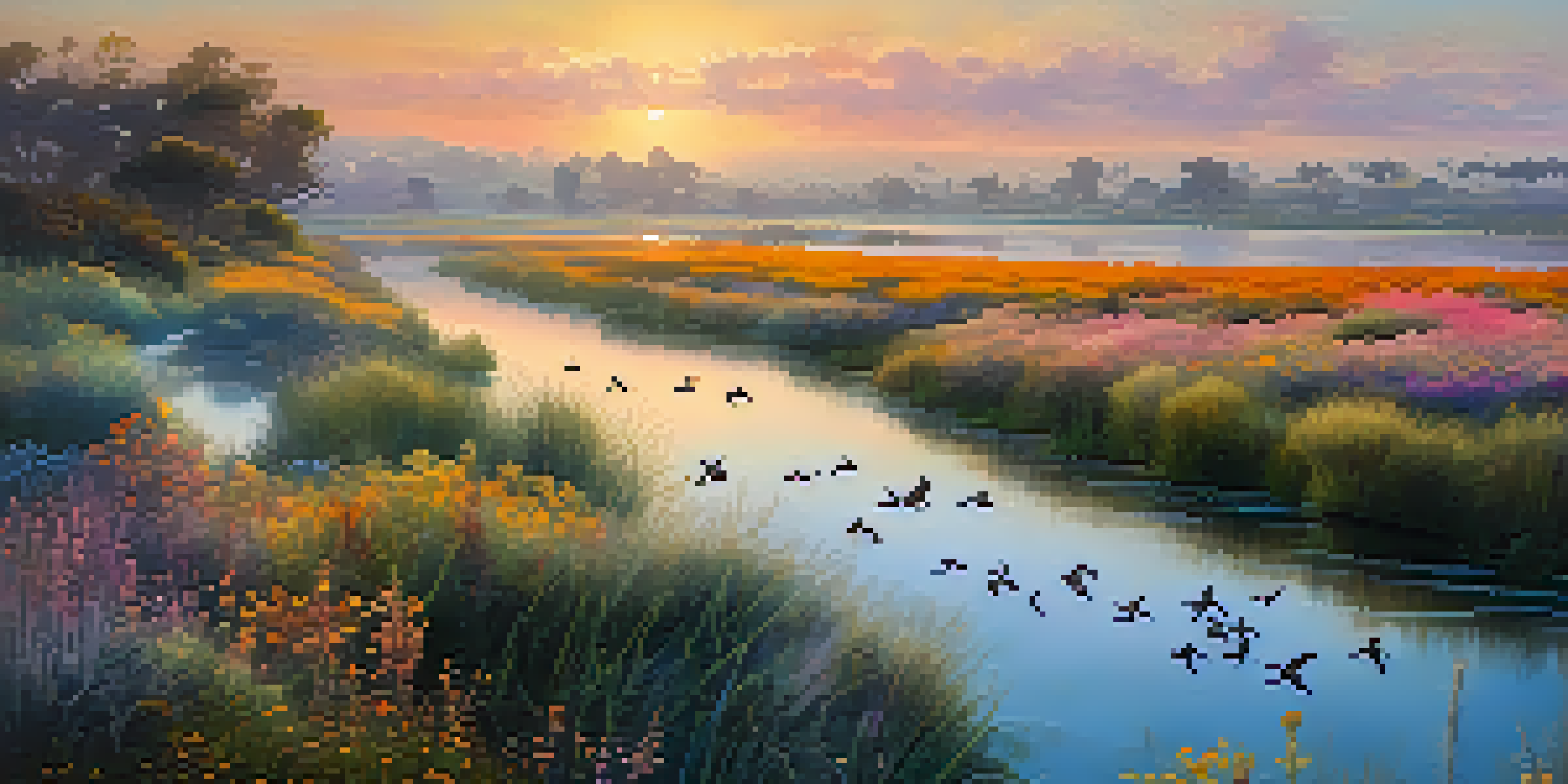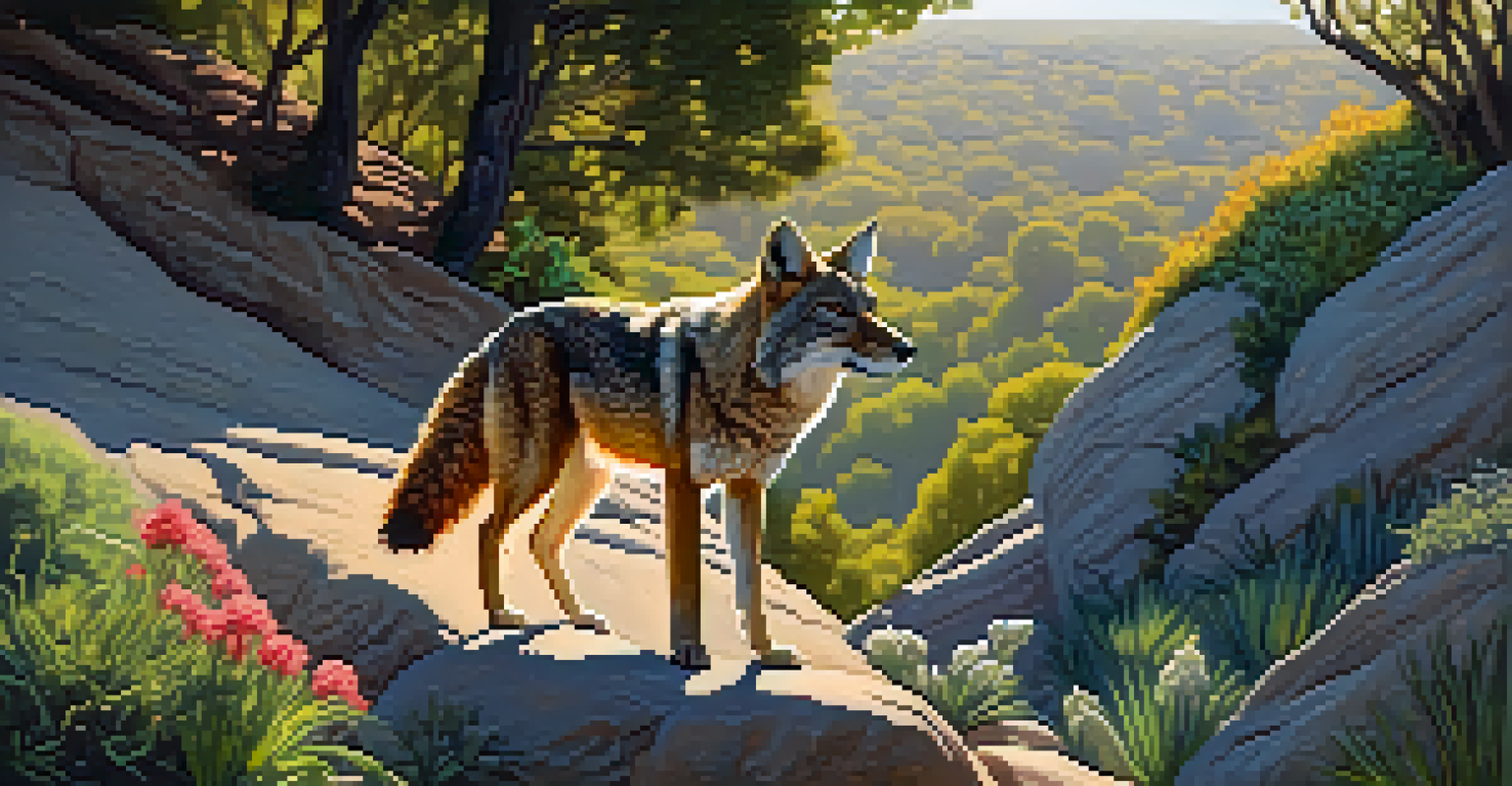Exploring Local Wildlife Habitats in Urban Los Angeles Areas

The Hidden Biodiversity of Urban Los Angeles
Los Angeles may be known for its bustling city life, but beneath the surface lies a rich tapestry of biodiversity. From the vibrant Santa Monica Mountains to the lush wetlands of the Ballona Creek, urban wildlife thrives in unexpected places. These habitats provide essential resources for countless species, including birds, mammals, and reptiles.
In every walk with nature one receives far more than he seeks.
Take a stroll through Griffith Park, for example, and you might just spot a coyote or a hawk soaring overhead. This urban oasis showcases how nature adapts and flourishes even amidst concrete and chaos. The variety of ecosystems found in LA demonstrates that wildlife can coexist with urban development, offering a unique glimpse into nature's resilience.
Understanding the hidden biodiversity of Los Angeles not only enriches our appreciation for the environment but also highlights the importance of conserving these habitats. By exploring these areas, we can foster a deeper connection with wildlife and promote sustainable practices to protect these vital ecosystems.
Key Urban Wildlife Habitats to Explore
Los Angeles is home to a multitude of urban wildlife habitats, each offering a unique experience. For instance, the wetlands of the Ballona Creek serve as a crucial stopover for migratory birds, making it a birdwatcher's paradise. Similarly, the coastal areas around the Pacific Ocean provide a habitat for marine life, including seals and sea otters.

Another gem is the LA River, which has undergone extensive revitalization efforts to enhance its ecological value. Kayaking down the river not only offers a fun adventure but also a chance to spot turtles and various fish species. These habitats showcase the diverse wildlife that can thrive even in urban settings.
Urban Wildlife Thrives in LA
Los Angeles hosts diverse ecosystems that support a variety of wildlife, showcasing nature's resilience amid urban development.
By exploring these key areas, residents and visitors alike can appreciate the beauty of nature right in their own backyard. It’s a reminder that urban spaces can be transformed into sanctuaries for wildlife, encouraging us all to engage with and protect these remarkable habitats.
The Importance of Urban Wildlife Conservation
Urban wildlife conservation is essential for maintaining biodiversity and ecological balance. As cities expand, many natural habitats are lost, endangering the species that rely on them. By prioritizing conservation efforts in urban settings, we can help protect these vital ecosystems for future generations.
The Earth has music for those who listen.
Initiatives like habitat restoration and the creation of green spaces play a crucial role in supporting urban wildlife. For instance, community gardens and parks not only beautify neighborhoods but also serve as essential habitats for various species. These efforts create a network of green spaces that allows wildlife to thrive amidst urban landscapes.
Engaging local communities in conservation initiatives fosters a sense of responsibility towards nature. By participating in local clean-up events or wildlife monitoring programs, residents can contribute to the preservation of these habitats. Ultimately, urban wildlife conservation is a shared responsibility, promoting a healthier environment for all.
Popular Wildlife Viewing Spots in LA
There are several prime locations in Los Angeles where wildlife enthusiasts can observe animals in their natural habitats. One such spot is the Los Angeles County Arboretum, which boasts a variety of plant species that attract different birds and butterflies. It’s an ideal place for a leisurely stroll while enjoying nature.
Another great destination is the Sepulveda Basin Wildlife Reserve, known for its diverse ecosystems and abundant birdlife. Here, visitors can explore trails and watch for herons, ducks, and even the occasional bobcat. The combination of water, wetlands, and open fields makes it a hotspot for wildlife viewing.
Conservation is a Community Effort
Engaging local communities in conservation initiatives fosters a sense of responsibility and helps protect vital urban wildlife habitats.
These locations not only provide opportunities to connect with nature but also serve as reminders of the importance of preserving urban wildlife habitats. They encourage visitors to take an active interest in the local flora and fauna, fostering a deeper appreciation for the biodiversity that exists within the city.
Engaging in Responsible Wildlife Observation
When observing wildlife, it’s essential to approach the experience responsibly. This means keeping a respectful distance from animals and avoiding actions that could disturb their natural behaviors. Using binoculars or a camera with a zoom lens allows for an immersive experience without intruding on their space.
Additionally, it's important to follow local guidelines and regulations when visiting wildlife habitats. Many areas have specific rules to ensure the safety of both wildlife and visitors. Familiarizing yourself with these guidelines not only enhances your experience but also protects the delicate ecosystems you are exploring.
Engaging in responsible wildlife observation fosters a harmonious relationship between humans and nature. By being mindful of our interactions with wildlife, we can help preserve these habitats for future generations and ensure that wildlife continues to thrive in urban areas.
Educational Programs and Resources for Wildlife Lovers
Los Angeles offers a variety of educational programs and resources for those interested in local wildlife. Organizations such as the California Wildlife Center provide workshops and volunteer opportunities, giving individuals hands-on experience in wildlife care and conservation. These programs serve as a fantastic way to learn more about the species that call LA home.
In addition, various nature centers and museums host educational events, guided tours, and nature walks. These activities cater to all ages and skill levels, allowing everyone to deepen their understanding of urban wildlife. Attending these events can be both fun and informative, making for great family outings.
Explore Key Wildlife Viewing Spots
Los Angeles offers many prime locations for wildlife observation, allowing residents and visitors to connect with nature right in the city.
Utilizing online resources, such as local wildlife forums and social media groups, can also enhance your knowledge of urban habitats. These platforms allow for sharing experiences and tips with fellow wildlife enthusiasts, creating a supportive community committed to wildlife education and conservation.
How to Get Involved in Local Wildlife Conservation
Getting involved in local wildlife conservation is easier than you might think! Many organizations in Los Angeles welcome volunteers for various initiatives, from habitat restoration projects to wildlife monitoring programs. By dedicating your time, you can make a tangible impact on the local environment.
Participating in community events, such as clean-up days at parks or wetlands, is another way to contribute. These events not only help improve habitats but also raise awareness about the importance of conservation. Engaging with your community fosters a sense of shared responsibility for protecting wildlife.

Lastly, advocating for wildlife-friendly policies and practices can amplify your efforts. Whether it’s supporting local legislation or promoting sustainable practices in your neighborhood, every action counts. Together, we can ensure that urban wildlife habitats in Los Angeles thrive for years to come.